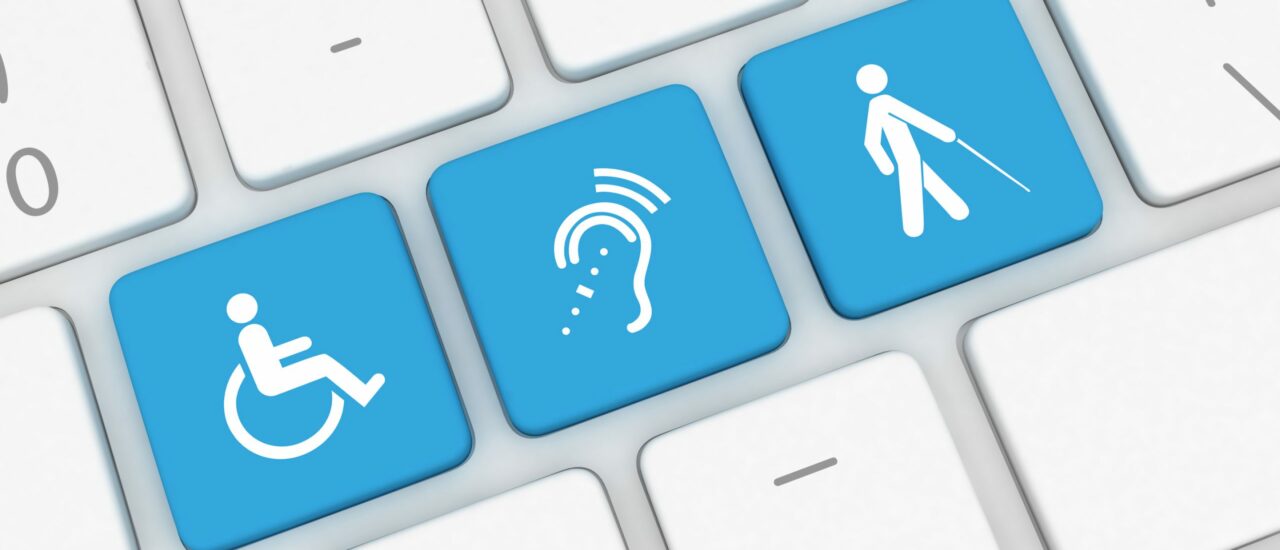Creating inclusive technology to connect us all has to be entirely inclusive. Providing accessibility online to approximately 3.8 million people with disabilities in the UK workforce alone presents an ongoing opportunity and a responsibility. In order to make e-learning accessible across the spectrum, we must understand the diversity of these accessibility challenges and create inclusive tech that works for all of us.
In designing online accessibility there are two major concerns; the physical or mental limitation blocking access, and secondly the social restriction in the form of inaccessible design, and exclusion for those with limited access to the internet. Accessibility has never been more important, the pandemic has significantly highlighted this and it means ensuring learning content is accessible to all learners whether they have a disability or not.
In the context of the legal requirement for all public sector websites to provide accessibility from September 2020, UK Universities are legally obligated to make reasonable, anticipatory adjustments to ensure those with disabilities are not discriminated against.
Catalyst learning technologists will demonstrate some of the ways the developers of online courses can make and bring better online learning experiences. In order to create and adapt online courses for all, it has been essential to understand the diversity of disabilities and therefore cater for all types of learner.
User interface, and content must be presented in a way to incorporate as many of a learners’ senses as possible. From within the e-learning course, ease of use for all is essential, including the navigation elements and user interface. The information and user interface presented must be self-evident. The course design and LMS must be open to reliable interpretation by a wide range of assistive technologies. Listening to your learning resources can be done through your smartphone as your course content has been optimised for these devices so you can access them, without difficulty, anywhere and anywhere.
The team at Catalyst understands how to create and develop interactive, accessible e-learning content.
Our course design process includes:
1. Designing with screen readers in mind
When creating content for screen readers there are a few things to consider punctuation, language and acronyms. Turn on-screen images and text into speech or display the content in Braille.
When it comes to acronyms, a screen reader can interpret these very differently to a human. It is often advisable to steer clear of acronyms and use the full variation of the phrase.
2. Checking the colour contrast
The use of contrasting colours in eLearning content enhances readability. Distinct colours can make data hard to interpret. For example people who have colour blindness may have difficulty in distinguishing between a variety of colours and therefore multiple shades often work better.
3. Adding subtitles to videos, and captions to images
When producing interactive videos add subtitles, and an introduction which clearly explains to the learner how they interact with it. The same applies for adding captions to images. Text alternative (more commonly known as ‘image alt text’) should be added in the event that a screen reader is speaking the content out loud to the learner.
4. Inclusive language
Inclusive language used within our action buttons compensates for difficulties such as the inability to use a mouse. For example in place of click here we substitute more explanatory phrases such as, ‘select this link to find out more’.
Students need to be able to learn with their own preferences, to be fully inclusive. They may prefer to learn by listening to audio materials despite having 20/20 vision. We would help them prepare to adapt their learning materials in this way – often referred to as universal design.
When building eLearning courses it is important to remember that not all interactions are accessible for all learners. Interactive webinars for example, may rely on the participant to drag and drop a series of answers at the end of a particular lesson. This is fine if the learner has access to a mouse, but what if they are accessing the course using only a keyboard? You may need to think about changing your content for a more accessible interaction.
At Catalyst we can offer advice on designing alternative assessment methods when required. Video assignment submission instead of essay for dyslexic student as an example.
E-learning courses have to be accessible to all, therefore it is important that we consider all possible users and the technological barriers they may face in engaging with all activities fully. For instance you may wish to evaluate the students learning part way through a course, by including a test which requires them to record their answers via webcam. This runs the risk of alienating those without access to a web based camera.
At Catalyst we consider all assessment methods within our e-learning design to ensure maximum engagement. Accessibility isn’t only encompassing disability support but, tech access and inclusivity. Simple preferences such as responsiveness and being able to work on the bus home from campus. The ‘accessible’ design approach for all ensures each learner has equal access. Accessible design means opening up your courses to a wider student audience.
In order to be effective and reach the widest possible audience, course content needs to be readily available on demand and in a format that suits the learner. Face to face delivery can’t survive on its own these days as students expect a blended approach to learning. This means the inclusion of audio visual material, group based activities, reading and practical tasks with different evaluation methods to provide assessment options. This is not to say that live sessions cannot be a useful way of delivering content however, without access given to the preparatory materials in advance the session could be unsuccessful. A clear outline of student conduct and learning outcomes specified in an agenda being made available prior to the event online can clear up much confusion on the day.
Multiple platforms must be catered for so material can be effortlessly accessed. Student body research should be conducted in order to evaluate the levels of access and engagement, e.g. Preferred technologies and students internet capabilities. For instance do they have adequate internet band width or are they topping up using their own phone data?
Adapting quickly to student feedback in both of these areas of platform and content is critical to student participation. Online learning solutions can be an efficient way to relate material to a large audience but difficult to evaluate in terms of effectiveness. Providing clears routes of feedback to the learners will enable the institution to track the effectiveness of the delivery method of its course material. Online polls, anonymous questionnaires and peer to peer forums will encourage an open and honest review of how the course is being delivered. Ignoring this could be to the detriment of student engagement and ultimately the course being deemed a success.
By bringing all these aspects together in harmony Catalyst will help you provide credibility to your digital content.

